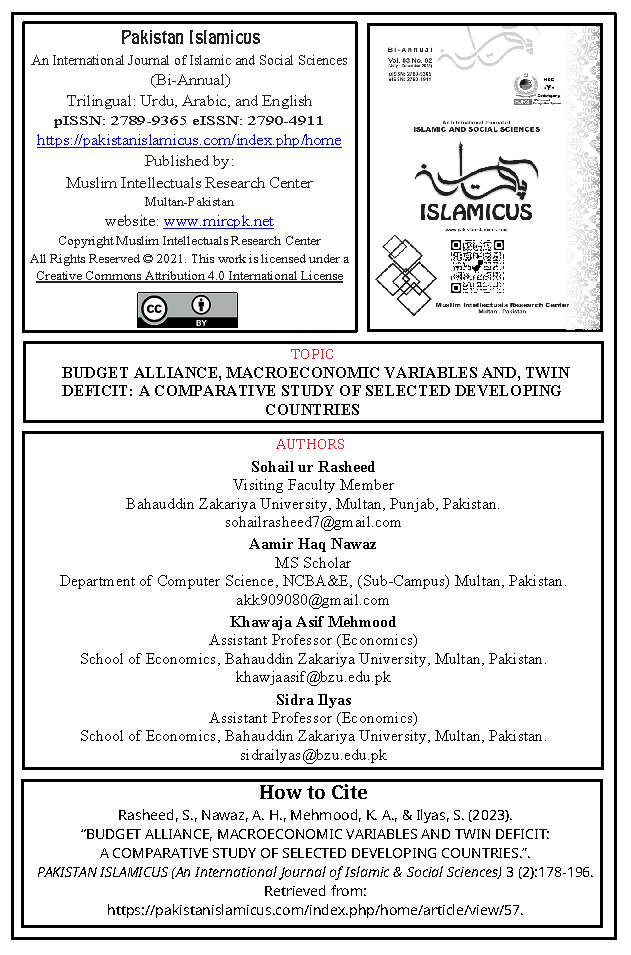BUDGET ALLIANCE, MACROECONOMIC VARIABLES, AND TWIN DEFICIT: A COMPARATIVE STUDY OF SELECTED DEVELOPING COUNTRIES
Keywords:
Current Account Balance, Fiscal Deficit, Real Effective Exchange Rate, Developing CountriesAbstract
This study investigates the nexus between BD and CAD by employing the ADF & ARDL tests from 2000 to 2020. Moreover, it is also examined that whether the Keynesian Theory of Proposition or Ricardian Equivalence Hypothesis is more appropriate for selected developing economies. The result revealed that FD & CAD are positive & significant for LIC and UMC. However, a negative coefficient was found for LMC and all developing countries. REER significantly affects the CAB for LMC, UMC and all developing countries except LIC. The impact of GFCF on CAB is negative for all cases. The coefficient of GDPPCG and Trade are insignificant for LIC. However, a significant relationship was found for LMC, UMC, and for all developing countries. This paper also pointed the theory of Keynesian proposition is more appropriate for LIC & UMC. Similarly, the theory of the Ricardian Equivalence Hypothesis is more suitable for LMC and all developing countries.
References
Abu, N and Gamal, A (2020). An empirical investigation of the twin deficits hypothesis in Nigeria: evidence from cointegration techniques: Contemporary Economics, 14(3), 285-305: doi. 10.5709/ce.1897-9254 405
Abbasi, M. A., Amran, A., Rehman, N. A., & Ali, A. (2021). Twin Deficit and Macroeconomic Indicators in Emerging Economies: A Comparative Study of Iran and Turkey. The Journal of Asian Finance, Economics and Business, 8(5), 617-626.
doi.org/10.13106/jafeb.2021.vol8.no5.0617
Achiles Shifidi and Jacob M. Nyambe (2020), Analysing the Relationship between Budget Deficit and Current Account Deficit in Namibia. Asian Journal of Economics, Business and Accounting, 15(3), 35-43. doi:10.9734/AJEBA/2020/v15i330217
Badaik, S., & Panda, P. K. (2020). Ricardian Equivalence, Feldstein–Horioka Puzzle and Twin Deficit Hypothesis in Indian Context: An Empirical Study. Journal of Public Affairs, 22(1), 1-8. doi.org/10.1002/pa.2346
Baharumshah, A. Z., Soon, S. V., & Wohar, M. E. (2019). Fiscal Stance, Foreign Capital Infows and the Behavior of Current Account in the Asian Countries. Empirical Economics, 56(2), 523–549. doi.org/10.1007/s00181-017-1368-5
Banday, U. J., & Aneja, R. (2019). Twin deficit hypothesis and reverse causality: a case study of China. Palgrave Communications, 5(1), 1-10. doi.org/10.1057/s41599-019-0304-z
Eze, T., C. (2023). Granger Causality Approach to the Confirmation of Post-Covid 19 Keynesian Twin-Deficit Hypothesis in Nigerian Economy. Journal of Economics and Allied Research, 8(1), 226-239. https://jearecons.com/index.php/jearecons/article/view/286
Chunming, Y. U. A. N., & Ruo, C. H. E. N. (2015). Policy Transmissions, External Imbalances, and their Impacts: Cross-country Evidence from BRICS. China Economic Review, 33, 1–24. doi.org/10.1016/j.chieco.2014.12.006
Damalie, N., Daniel, A. (2019). The Twin Deficit Hypothesis: An Empirical Analysis for Uganda. North American Academic Research, 2(7), 239-271.doi.org/10.5281/zenodo.3357228
Dey, S.R. and Tareque, M. (2022), "Twin deficits hypothesis in Bangladesh: an empirical investigation", International Journal of Emerging Markets, Vol. ahead-of-print No. ahead-of-print. doi.org/10.1108/IJOEM-06-2020-0628
Epaphra, M. (2017). The Twin Deficits Hypothesis: An Empirical Analysis for Tanzania. The Romanian Economic Journal, 20(65), 2-34.
El-Khishin, S., & El-Saeed, J. (2021). The Twin Deficit Hypothesis in the MENA Region: Do Geopolitics Matter?. Economies, 9(3), 124. doi.org/10.3390/economies9030124
Halil, S. I., & Uulbolsun, N. (2022). Twin Deficit Hypothesis: An Empirical Study on the Economy of Kyrgyzstan. Reforma (1694-5158), 95(3), 6-17.
Hassan, M. S., Wajid, A., Mahmood, H., & Shahbaz, M. (2015). Testing relevance of twin deficit for a transition economy like Pakistan. Transylvanian Review of Administrative Sciences, 11(46), 91-106. https://rtsa.ro/tras/index.php/tras/article/download/453/442
Hussain, I., Hayat, U., Alam, M. S., & Khan, U. (2023). A Dynamic Analysis of the Twin-Deficit Hypothesis: the Case of a Developing Country. Asia-Pacific Financial Markets, 1-28. doi.org/10.1007/s10690-023-09405-y
Hailemareiam, A., F. (2023). The Twin Deficits Hypothesis: An Empirical Analysis for Ethiopia. American Journal of Theoretical and Applied Business, 9(2), 57. doi:10.11648/j.ajtab.20230902.15
Im, K. S., Pesaran, M. H., & Shin, Y. (2003). Testing for Unit Roots in Heterogeneous Panels. Journal of Econometrics, 115(1), 53–74. doi.org/10.1016/ S0304-4076(03)00092-7
Jayasooriya, S. (2020). Movement of Exchange Rate on Balance-of-Payments Constrained Growth in South Asia: Panel ARDL. MPRA Paper 98733, University Library of Munich, Germany. https://mpra.ub.uni-muenchen.de/98733/
Kafle, P. K., Chhetri, P., & Poudel, S. (2022). An Empirical Investigation for the Twin Deficit Hypothesis in Nepal. International Journal of Social Sciences: Current and Future Research Trends, 15(1), 1–27. https://ijsscfrtjournal.isrra.org/index.php/Social_Science_Journal
K. R. Kharel. & S. Kharel. (2020). Trade Deficit in Nepal: Relationship between Trade Deficit and Budget Deficits. Molung Educational Frontier, 10, 95–108. doi.org/10.3126/mef.v10i0.34076
Khan, M. A., Jaffri, A. A., Abbas, F., and Haider, A. (2017). Does Trade Liberalization Improve Trade Balance in Pakistan? South Asia Economic Journal, 18(2), 158-183. doi.org/10.1177/1391561417713128
Kalaj, E. H., & Mema, M. (2015). Investigating the Twin Deficits in Albania. EJSER European Journal of Social Sciences Education and Research Articles, 3(2).
doi.org/10.26417/ejser.v3i2.p69-73
Levin, A., Lin, C. F., & Chu, C. S. J. (2002). Unit Root Tests in Panel Data: Asymptotic and Finite-sample Properties. Journal of Econometrics, 108(1), 1–24.
doi.org/10.1016/S0304-4076(01)00098-7
Mohammadi, H., & Moshref, G. (2012). Fiscal Policy and the Current Account New Evidence from Four East Asian countries. Applied Economics Letters, 19(2), 167–173. doi.org/10.1080/13504851.2011.570703
Mehta, D., & Mallikarjun, M. (2023). Impact of fiscal deficit and trade openness on current account deficit in India: new evidence on twin deficits hypothesis. EconomiA Emerald Publishing Limited. doi10.1108/ECON-07-2022-0091
Mohanty, R. K. (2019). An Empirical Investigation of Twin Defcits Hypothesis: Evidence from India. Journal of Quantitative Economics, 17(3), 579–601.
doi.org/10.1007/s40953- 018-0136-5
Mukhtar, T., Jehan, Z., & Maryam, K. (2021). Asymmetries in Twin Deficits Hypothesis: An Empirical Assessment for Pakistan. Pakistan Economic and Social Review, 59(2), 253-285.
Nautiyal, N., Belwal, S., & Belwal, R. (2022). Assessment, Interaction and the Transmission Process of Twin Deficit Hypothesis: Fresh Evidence from India. Business Perspectives and Research, 11(2), 269-286. doi.org/10.1177/22785337211070378
Njoroge, E. K., Kosimbei, G., & Korir, J. (2014). Testing twin deficit hypothesis for Kenya 1970-2012. International Journal of Business and Economics Research, 3(5), 160-169.
doi: 10.11648/j.ijber.20140305.11
Okafor, S., Sylvester, E. C., Ifebi, O., Dimnwobi, S. K., & Asongu, S. (2021). Testing the Triple Deficit Hypothesis for Sub-Saharan Africa: Implications for the African Continental Free Trade Area. Forthcoming: African Development Review, EXCAS Working Paper WP/21/093. https://mpra.ub.uni-muenchen.de/111839/
Okafor, S. N., Ekesiobi, C., Ifebi, O., Dimnwobi, S. K., & Asongu, S. A. (2022). Testing the Triple Deficit Hypothesis for Sub‐Saharan Africa: Implications for the African Continental Free Trade Area. African development review, 34(1), 142-153.
doi.org/10.1111/1467-8268.12616
Oshota, S. O., & Badejo, A. A. (2015). What drives current account balance in West Africa states: Evidence from panel ARDL? Journal of International and Global Economic Studies, 8(2), 91-105.
Ravinthirakumaran, N., Selvanathan, S., & Selvanathan, E. A. (2015). The twin Defcits Hypothesis in the SAARC Countries: An Empirical Investigation. Journal of the Asia Pacific Economy, 21(1), 77–90. doi.org/10.1080/13547860.2015.1053592.
Ramu, A. M. (2017). Twin deficits’ hypothesis: An assessment of relationship and transmission mechanism in India. Foreign Trade Review, 52(1), 15-29.
doi.org/10.1177/0015732516650825.
Rehman, A., & Saeed, S. (2017). Validity of twin deficit hypothesis in case of Pakistan: Using different co-integration techniques. Economics, Commerce and Trade Management: An International Journal, 1(1), 45-57. https://airccse.com/ectij/papers/1117ectij04.pdf
Rehman, N. A., Shamshir, M., & Shakir, K. (2020). Correlation of Macroeconomic Variables with Twin Deficit in Pakistan. IBT Journal of Business Studies (JBS), 16(1), 1-16. doi.10.46745/ilma.jbs.2020.16.01.01
Sakyi, D. and Opoku, O. E. E. (2016). The Twin Deficits Hypothesis in Developing Countries: Empirical Evidence for Ghana (Technical No. S-33201-GHA-1). International Growth Centre, 1-32.
Saba, S. (2015). The Effect of Inflation Uncertainty on Budget Deficit: Evidence from Iran. Developing Country Studies, 5(11), 41-46.
Samotu, I. A., Orisadare, M. A., & Olaoye, O. (2020). Twin Deficit Hypothesis In The Presence Of Structural Breaks in Nigeria. Ilorin Journal of Economic Policy, 7(1), 35-48.
Samsu, S., H. and Ismail, N., A. (2020). The Relationship between the Current Account Balance and Its Determinants of Selected Middle-Income Countries. Quantum Journal of Social Sciences and Humanities, 1(4), 1-14.
Tufail, M. K., Anwar, S., & Abbas, K. (2014). Effect of budget deficit on trade deficit in Pakistan (a time series analysis). Journal of Finance and Economics, 2(5), 145-148. doi:10.12691/jfe-2-5-2
Van Bon, N. (2014). Current Account and Fiscal Deficits Evidence of Twin Divergence from Selected Developing Economies of Asia. Southeast Asian journal of economics, 2(2), 33-48. https://so05.tci-thaijo.org/index.php/saje/article/view/48770
Yasmin, F. (2015). Twin Deficit Hypothesis: A Case of Pakistan. Sukkur IBA Journal of Management and Business, 2(1), 71-84. doi.org/10.30537/sijmb.v2i1.89

Downloads
Published
Issue
Section
License
Copyright (c) 2023 PAKISTAN ISLAMICUS (An International Journal of Islamic & Social Sciences)

This work is licensed under a Creative Commons Attribution 4.0 International License.
This work is licensed under a Creative Commons Attribution 4.0 International License.

































